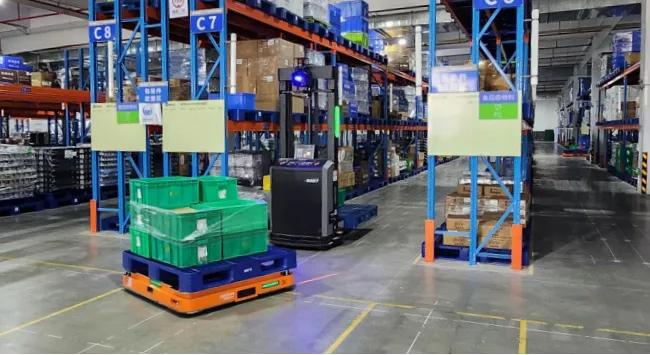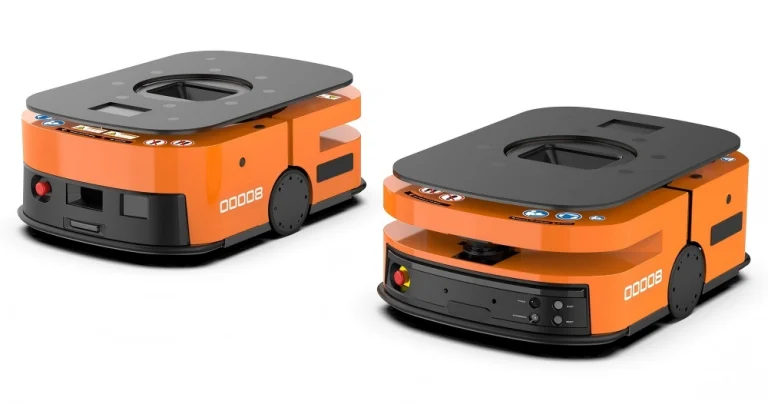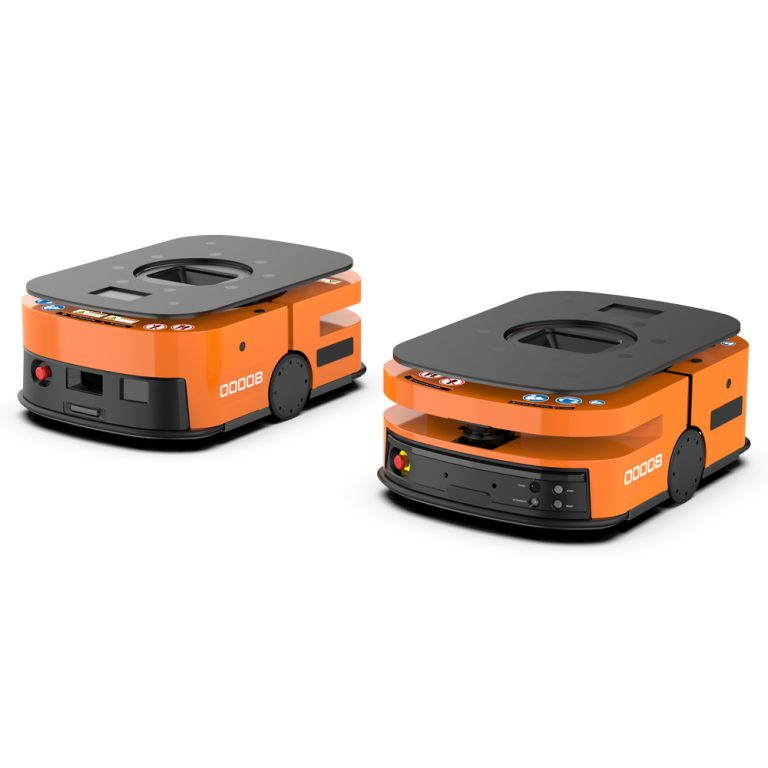Introduction: When E-commerce Peaks, Warehouses Feel the Pressure
Every year, peak seasons arrive like a fast-moving storm. Singles’ Day, Black Friday, holiday shopping, and anniversary sales all push e-commerce warehouses far beyond their usual limits. Orders pile up. Picking paths get crowded. Workers rush from one end of the building to the other, often covering miles in a single shift.
And right at the center of this chaos is one painful truth:
Most warehouse bottlenecks come from slow, manual handling of shelves and goods—not from a lack of orders.
That’s why more e-commerce companies are turning to 潜在移动机器人(LMR). These robots work underneath racks, lifting and moving inventory with speed and accuracy. They don’t need breaks, they don’t get tired, and they don’t get confused when order volume spikes in the middle of the night.
Before peak season hits again, let’s break down how LMRs directly fix warehouse overload—and why so many fast-growing e-commerce teams are adopting them.

1. Understanding Warehouse Overload in E-commerce
1.1 Why Peak Seasons Push Warehouses to Their Limits
Peak-season overload usually comes from a mix of factors:
- A sudden jump in incoming orders
- A shortage of trained temporary workers
- Slow rack-to-worker movement
- Long picking paths (especially in large warehouses)
- Real-time changes in hot-selling SKUs
- Inventory stored too far from the shipping zone
In big e-commerce centers, a single picker may walk 15–20 kilometers per day. When traffic jams build up in aisles, everything slows down—even automated lines.
Once orders start falling behind schedule, the backlog snowballs.
1.2 Where Traditional Manual Systems Break Down
Manual picking has a few unavoidable weaknesses:
- Workers must physically locate items
- Racks stay fixed even if sales trends shift
- Human fatigue slows down speed through the day
- New temporary workers make mistakes
- Sudden SKU growth forces the warehouse to “stretch” layout limits
This model simply wasn’t built for modern e-commerce speeds.
2. How Latent Mobile Robots Transform Peak-Season Operations
Latent Mobile Robots work in a different way. Instead of sending workers deep into aisles, the robots bring entire shelves to the picking station.
This one shift solves several core problems at once.

2.1 They Reduce Walking Distance to Almost Zero
Pickers stay at one workstation while LMRs move goods back and forth.
A warehouse that once required 50 pickers might only need 10 or 12.
Real example:
During a mid-year sale, a warehouse using LMRs saw average walking distance per picker drop from 18 km/day to under 1 km/day.
Less walking = faster picking + fewer errors + safer work conditions.
2.2 LMRs Move Shelves Faster Than Any Worker Can
An LMR slides under a rack, lifts it, and carries it to a station.
It doesn’t hesitate or “look around for item location.”
It follows a dynamic route that updates every second.
Benefits include:
- No aisle congestion
- Smooth, predictable flow
- 24/7 operation capability
- Fast switching between slow-moving and hot SKUs
Where humans slow down after long shifts, robots keep the same pace all day.
2.3 Real-Time Adaptation When Certain Items Explode in Demand
During peak sales, one item often becomes a surprise hit.
With manual systems, workers need to rearrange shelves or stock forward locations. It takes hours—sometimes an entire day.
LMRs adapt instantly:
- Robots automatically bring hot-selling racks to the front
- The system updates rack priority in real time
- No physical layout changes needed
This flexibility is a game changer for fast-moving e-commerce.
3. Solving Specific Peak-Season Problems with Latent Mobile Robots
Below is a clear breakdown of how LMRs address real pain points:
| Peak-Season Problem | Impact on Warehouse | LMR Solution |
|---|---|---|
| Too many orders in short time | Backlog, late shipments | Robots speed up rack movement |
| Lack of temp labor | Orders unprocessed | LMRs reduce need for extra workers |
| Mis-picks by new staff | Returns and extra cost | Robots guide workers at stations |
| Traffic jams in aisles | Slow picking | Autonomous navigation prevents congestion |
| Hot-selling SKU spikes | Inventory mismatch | System reprioritizes racks automatically |
| Fatigued workers | Drop in productivity | Robots maintain constant rhythm |
Every line in the table connects to one truth:
LMRs attack the root cause of overload, not the symptoms.
4. Why Latent Mobile Robots Fit E-commerce Better Than Other Automation
4.1 Flexible Layout, No Need for Heavy Reconstruction
Installing automated conveyors or fully automated AS/RS systems takes months.
They also require large upfront construction work.
LMRs only need:
- floor stickers
- shelf adapters
- an open area for robot movement
No heavy restructuring. No long downtime.
4.2 Perfect for Seasonal or Unpredictable Order Surges
Since robots can be added or removed easily, an e-commerce warehouse can scale up rapidly when peak season hits, then scale down afterward.
This keeps operating costs under control.
4.3 High Accuracy Under Pressure
Peak seasons often push workers into “rushed mode.”
Mistakes happen.
With LMRs:
- The system guides workers to the right bin
- LED indicators show the correct picking spot
- Rack orientation stays consistent
- The system validates every pickAccuracy goes up even when orders multiply.
5. About Wesar Intelligence Co., Ltd.: A Reliable Partner for Latent Mobile Robots
威萨智能股份有限公司有限公司。 focuses on intelligent logistics equipment designed for modern warehouses, especially fast-moving e-commerce operations.
The company offers:
- Latent Mobile Robots designed for stable lifting and smooth rack transport
- Smart scheduling systems for multi-robot cooperation
- Integrated picking stations
- Flexible deployment tailored to real warehouse conditions
WESAR’s solutions are already used in warehouses handling daily peaks, flash sales, and cross-border e-commerce tasks. What makes the company stand out is its hands-on engineering approach—designing hardware and software that work reliably in crowded, high-pressure warehouse environments.
结论
Warehouse overload in e-commerce isn’t caused by a lack of hard work. It comes from systems that can’t keep up with the speed of online shopping.
Latent Mobile Robots change that. They reduce walking, speed up rack movement, increase accuracy, and adapt instantly to fast-changing SKUs. For peak-season challenges, they offer not just convenience, but stability—something every e-commerce operation needs to protect its brand reputation.
With the right robot system, peak season stops feeling like a crisis and starts becoming an opportunity.
FAQs: Latent Mobile Robots in E-commerce
Q1: How do Latent Mobile Robots help during peak-season overload?
They cut manual walking and move racks automatically, speeding up order processing even when demand spikes.
Q2: Can LMRs handle sudden changes in hot-selling products?
Yes. The system adjusts rack priority in real time, bringing popular items to picking stations faster.
Q3: Are LMRs difficult to install in existing warehouses?
Not at all. They require minimal layout changes and can be deployed in weeks, not months.
Q4: How do LMRs improve accuracy in e-commerce picking?
Robots bring the correct rack and guide workers with lights or screens, reducing wrong picks.
Q5: Can Latent Mobile Robots run 24/7?
Yes. They operate continuously with scheduled charging, making them ideal for fast-moving e-commerce warehouses.








